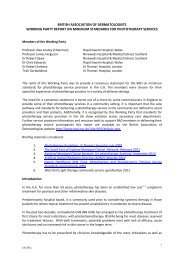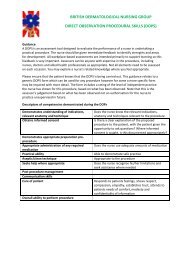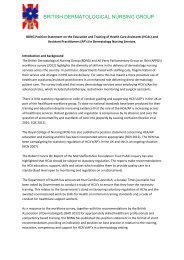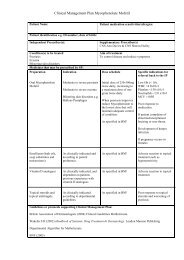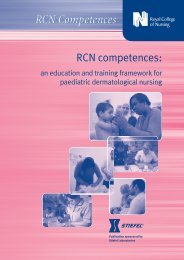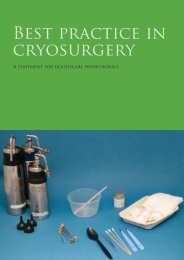Improving outcomes for people with skin tumours including melanoma
Improving outcomes for people with skin tumours including melanoma
Improving outcomes for people with skin tumours including melanoma
Create successful ePaper yourself
Turn your PDF publications into a flip-book with our unique Google optimized e-Paper software.
3<br />
<strong>Improving</strong> Outcomes <strong>for</strong><br />
People <strong>with</strong> Skin Tumours<br />
<strong>including</strong> Melanoma<br />
Organisation of <strong>skin</strong><br />
cancer services<br />
• Histopathologists. Ideally there should be at least two specialist<br />
dermatopathologists or histopathologists <strong>with</strong> a special interest<br />
in dermatopathology. This is to provide flexibility and adequate<br />
cover during leave periods. There should be a designated lead<br />
in the area and ideally a deputy lead. The lead and deputy lead<br />
engaged in reviewing and reporting SSMDT <strong>skin</strong> cancer cases<br />
should each attend over 50% of SSMDTs. Other histopathologists<br />
reviewing and reporting SSMDT work should be able to<br />
demonstrate some MDT activity. All specialist histopathologists<br />
reviewing and reporting common and rare <strong>skin</strong> cancers should<br />
be able to demonstrate experience, competency and skills<br />
sufficient to fulfil the task, or undertake appropriate training to<br />
acquire the skills. The level of competence and skills <strong>for</strong> this<br />
activity is broadly that of the RCPath Diploma in<br />
Dermatopathology and American Board Certification in<br />
Dermatopathology. These qualifications are not, however,<br />
regarded as mandatory. All specialist histopathologists engaged<br />
in this work should participate in some CPD relevant to<br />
common and rare <strong>skin</strong> cancers and participate in an appropriate<br />
EQA scheme. Ideally this should be a national specialist EQA<br />
scheme in dermatopathology, when available. Those reporting<br />
primary cutaneous lymphoma must participate in an EQA<br />
scheme <strong>including</strong> this group of diseases. It is also desirable that<br />
the CPD is facilitated by membership of appropriate national<br />
societies (such as the British Society <strong>for</strong> Dermatopathology<br />
and/or the UK Cutaneous Lymphoma Group). Each cancer or<br />
pathology network could hold a panel of histopathologists<br />
suitable <strong>for</strong> SSMDT participation based on these criteria.<br />
Histopathologists restricting their activity in the SSMDT centre to<br />
work at the LSMDT level should be able to demonstrate the<br />
same activity as defined previously. It is acknowledged that<br />
because of work<strong>for</strong>ce shortages in histopathology there could be<br />
an implementation delay of these goals in some centres.<br />
• Radiologists. Cross-sectional imaging is important <strong>for</strong> staging<br />
new cases and managing advanced cases. Sessional time must<br />
be identified to allow the radiologists to prepare <strong>for</strong> and attend<br />
the MDT meeting.<br />
• Clinical oncologists. A designated clinical oncologist should be<br />
identified as a member of the SSMDT and should be present in<br />
both the clinic and MDT review meeting.<br />
• Medical oncologist. A designated medical oncologist should be<br />
identified as a member of the SSMDT and should be present in<br />
both the clinic and MDT review meeting.<br />
60<br />
National Institute <strong>for</strong> Health and Clinical Excellence




